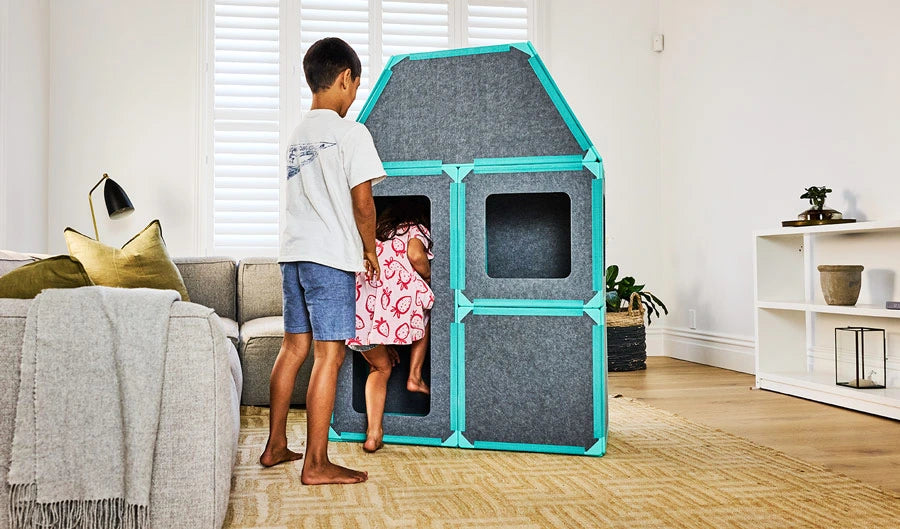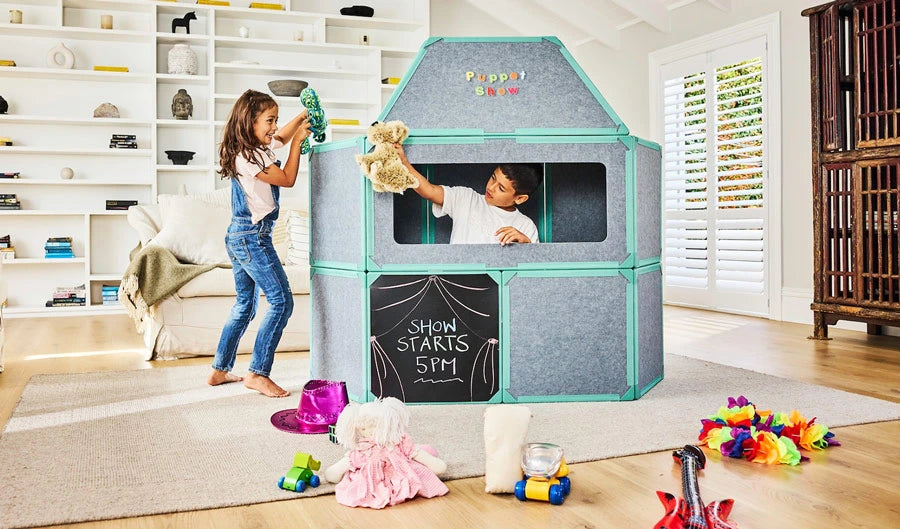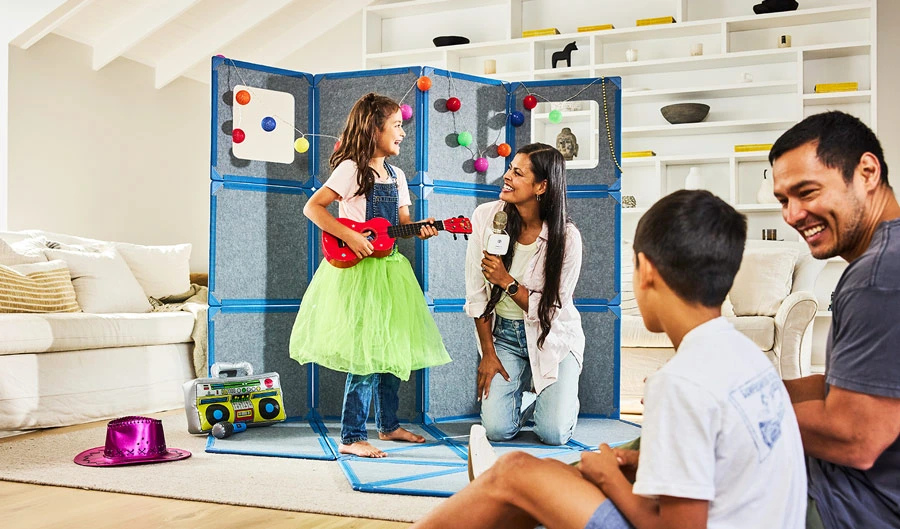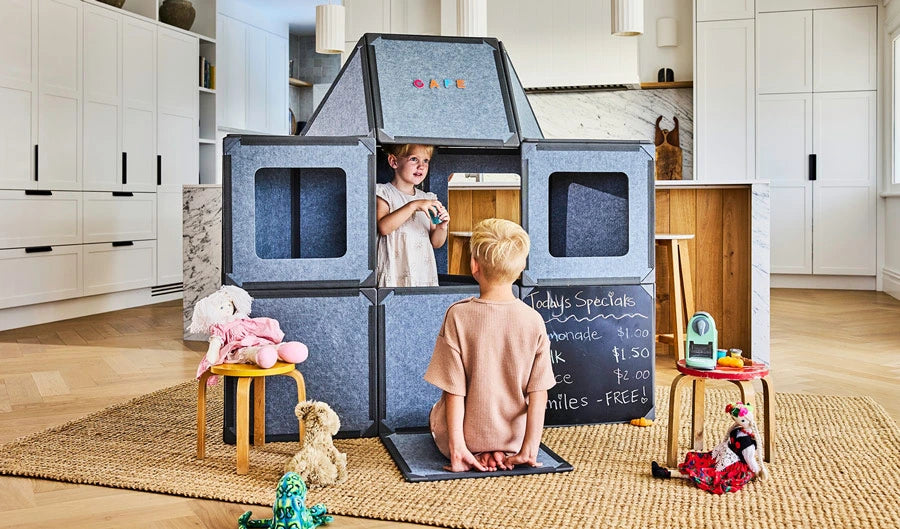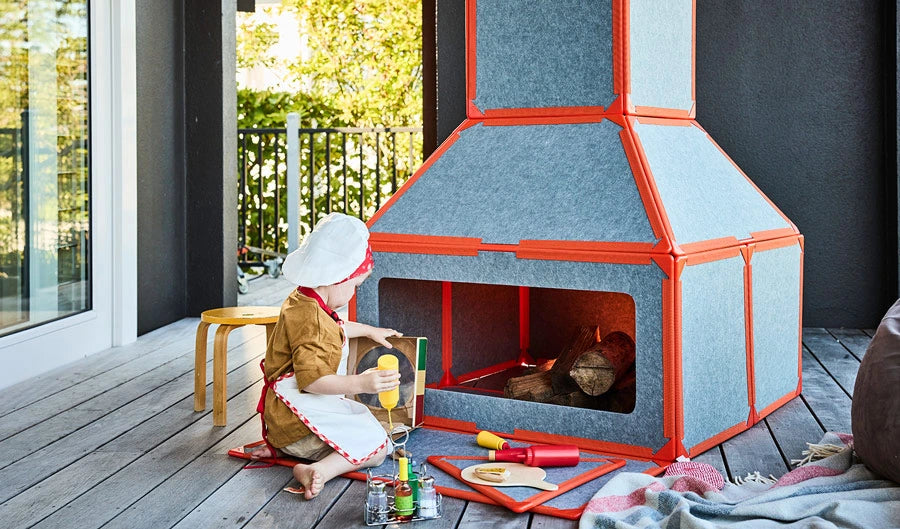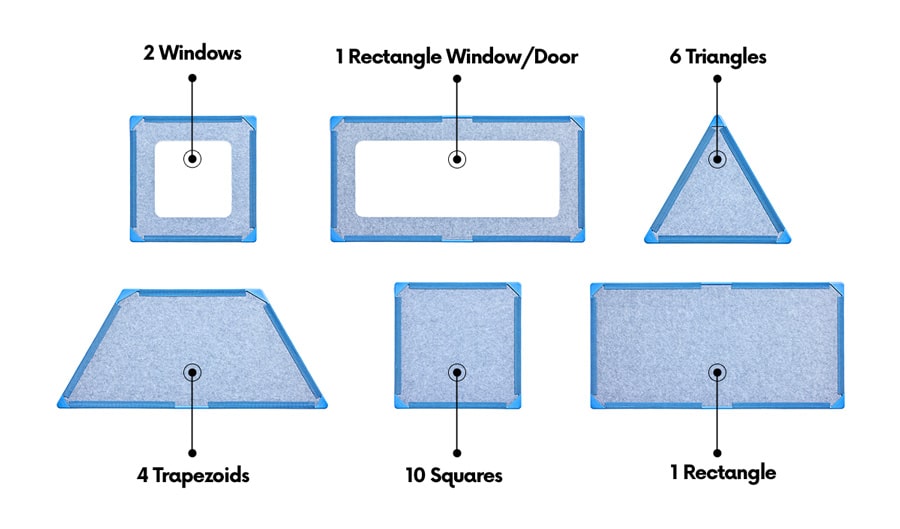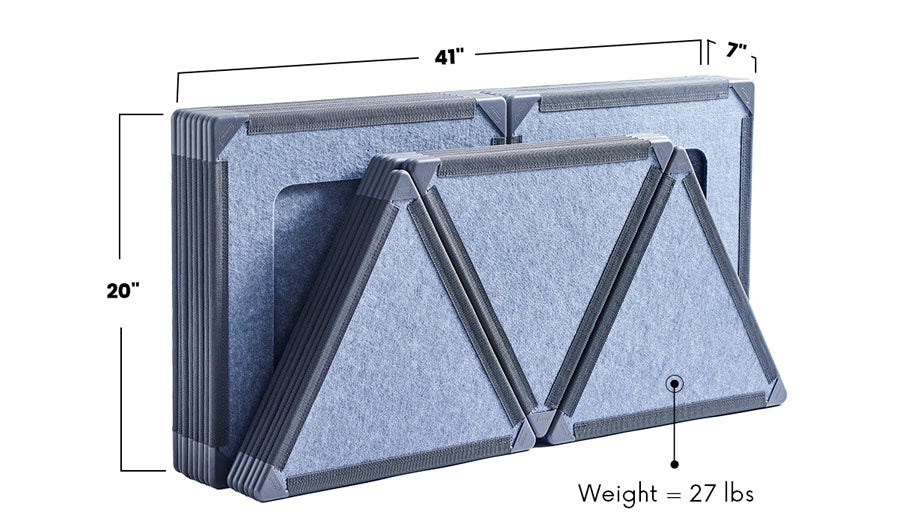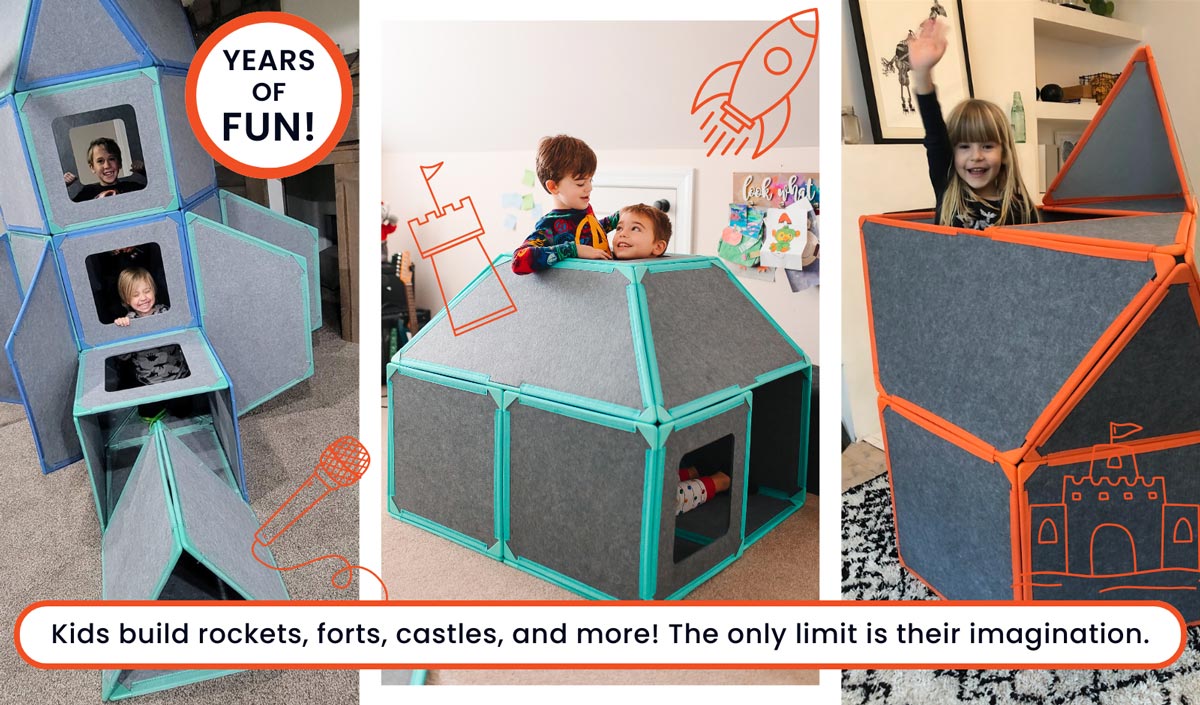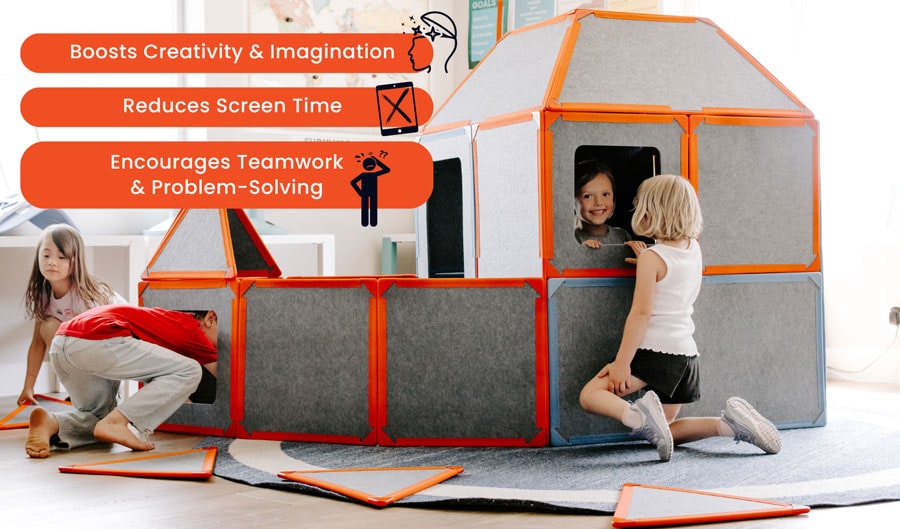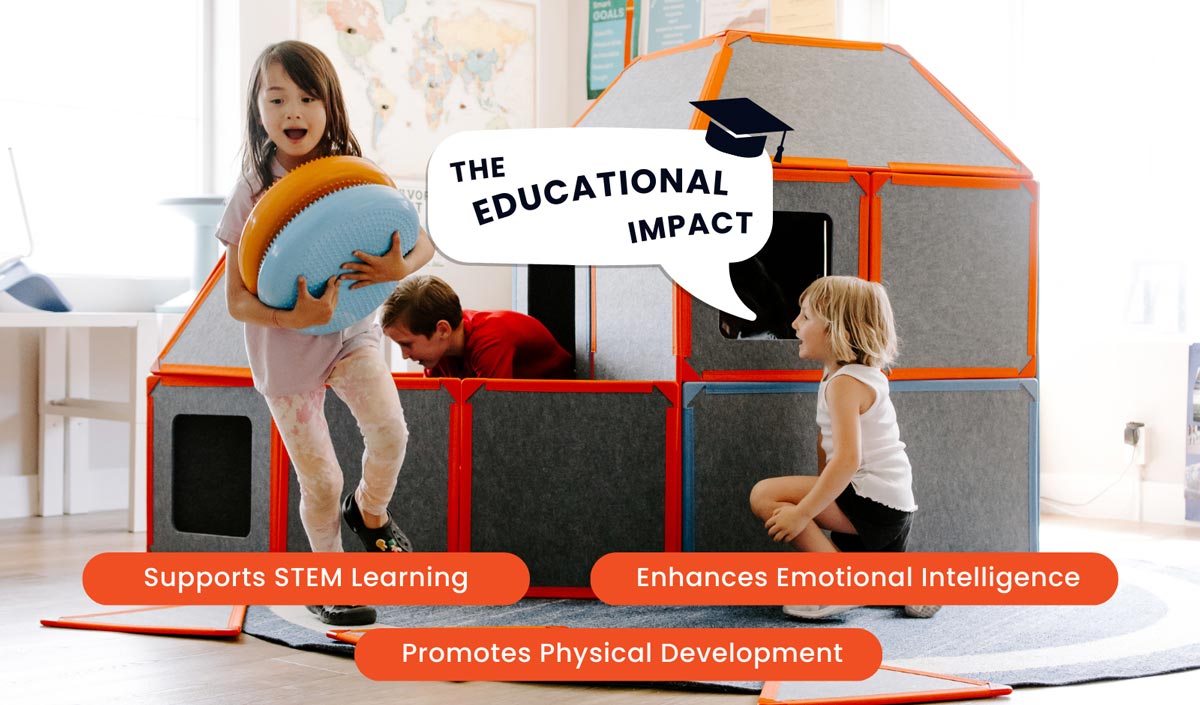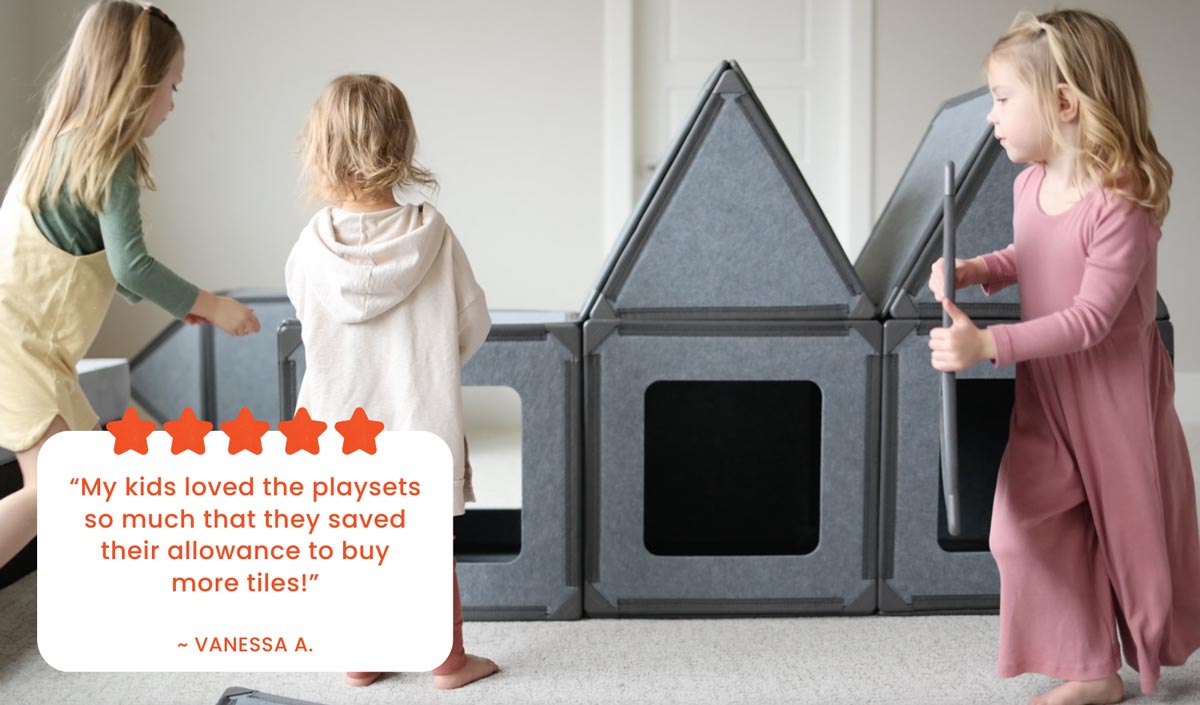Best Sensory Play Toys 2025: Complete Guide for Parents & Educators
Craig SpencerYour child is bouncing off the walls, struggling to focus, and you've noticed meltdowns happening more often. You're not alone.
Sensory toys for kids are the solution. Searches have exploded by 8,438% in the past year as parents discover their power.
If your living room has become a constant blanket fort zone and you're tired of rebuilding collapsed cushion structures, you're experiencing what thousands of parents discover daily.
Research shows multi-sensory toys create stronger neural connections, leading to deeper learning and longer retention [3].
The best sensory toys for kids engage multiple senses simultaneously, supporting everything from language development to emotional regulation. Superspace magnetic building tiles engage all seven senses while encouraging full-body movement.
This guide will help you choose sensory play toys backed by science.

Key Takeaways
- Sensory play toys engage multiple senses simultaneously, creating stronger neural connections and supporting brain development through hands-on exploration.
- Research shows multi-sensory toys improve attention span, learning retention, and language acquisition by 18.6 days per additional sense engaged.
- The best sensory toys target all seven senses, including often-overlooked vestibular (movement) and proprioceptive (body awareness) systems.
- Magnetic building tiles like Superspace provide full-body sensory engagement that traditional tabletop toys cannot offer, making them ideal for gross motor development.
- Sensory integration therapy shows significant benefits for autism (1.35 effect size) and ADHD (1.06 effect size), making sensory toys valuable therapeutic tools.
- Age-appropriate selection matters: choose toys that match your child's developmental stage, sensory preferences, and individual needs for maximum benefit.
- Multi-sensory play supports social skills, emotional regulation, and adaptive behavior more effectively than single-sense toys, according to peer-reviewed research.
Table of Contents
What Are Sensory Play Toys?
Sensory toys for kids are specially designed tools that engage one or more of your child's senses, creating rich learning experiences through hands-on exploration. Unlike traditional toys focused solely on entertainment, sensory toys serve as developmental infrastructure, building the neural pathways that support thinking, memory, and learning.
These toys do more than keep kids busy. They provide the sensory input children's brains need to organize information, regulate emotions, and develop critical life skills.
Research confirms that multisensory integration capacity reaches maturity late in childhood, making early sensory experiences critical for optimal development [2].

The 7 Senses of Sensory Play
Most people recognize five basic senses, but sensory play actually engages seven distinct sensory systems. Understanding all seven helps you choose toys that provide comprehensive developmental support.
1. Tactile (Touch): Textures, temperatures, pressures felt through skin receptors. Examples include smooth surfaces, bumpy textures, squishy materials, and varying resistances.
2. Visual (Sight): Colors, patterns, light, movement, and spatial relationships processed through the eyes. Includes transparent materials, color-mixing, and light play.
3. Auditory (Hearing): Sounds, music, rhythms, and auditory patterns. Ranges from gentle chimes to satisfying clicks and snaps.
4. Olfactory (Smell): Scents and aromas that can be calming or alerting. While less emphasized in toys, non-toxic materials should have pleasant or neutral scents.
5. Gustatory (Taste): Flavors and oral exploration. For toys, this means using safe, non-toxic materials that toddlers can safely put in their mouths.
6. Vestibular (Movement): Balance, spatial orientation, and body position in space. This system, located in the inner ear, processes information about head position and motion.
7. Proprioceptive (Body Awareness): Muscle and joint feedback providing information about body position, force, and movement. This sense tells us where our body parts are without looking.
Dr. A. Jean Ayers, who developed the sensory integration framework in the 1970s, established that "intersensory integration is foundational to function" [6].
Dysfunction in sensory integration can lead to difficulties in development, learning, and emotional regulation.
How Sensory Play Supports Development
Sensory play toys support child development across multiple domains simultaneously, creating a foundation for complex skills.
Brain Development: Sensory experiences form neural pathways supporting thought, memory, and language. Multiple senses create stronger connections [2].
Emotional Regulation: Sensory input helps children manage feelings and stress. The right toys provide calming or organizing input for self-regulation.
Motor Skills: Sensory play develops fine motor skills (hand-eye coordination, finger strength) and gross motor skills (balance, whole-body coordination).
Language Development: Multi-sensory experiences accelerate vocabulary acquisition. Children learn words 18.6 days earlier for each additional sense engaged [4].
Social Skills: Cooperative sensory play encourages communication and problem-solving. Research shows large effects on social development [1].
Cognitive Growth: Sensory exploration builds problem-solving, creativity, and cause-and-effect understanding.
Research-Backed Benefits
The benefits of sensory play aren't just anecdotal. Peer-reviewed research demonstrates measurable improvements across multiple areas.
A 2024 comparative study found that "by simultaneously engaging multiple senses such as visual, auditory, tactile, educational experiences become more robust and durable" [3].
Multi-sensory toys significantly improved attention span compared to traditional toys.
Children with poor multisensory integration skills show weaker verbal processing than expected for their age and intelligence level [2].
This suggests that sensory play isn't optional, it's essential.
A systematic review examining sensory integration therapy found large effects on social skills (1.22 effect size), adaptive behavior (1.15 effect size), autism spectrum disorder (1.35 effect size), and ADHD (1.06 effect size) [1].
Medium effects were observed for sensory processing itself (0.85 effect size).
The research is clear: multi-sensory engagement creates stronger learning outcomes, better retention, and more comprehensive development than single-sense stimulation.

Types of Sensory Play Toys
Tactile Sensory Toys
Tactile sensory toys engage the sense of touch through varied textures, temperatures, and resistances. These toys help children develop tactile discrimination, the ability to identify objects and qualities through touch alone.
Common tactile toys include playdough, kinetic sand, therapy putty, textured balls, fidget tools, and sensory bins filled with rice, beans, or water beads. Each provides unique tactile feedback that stimulates touch receptors in the skin.
Tactile play develops fine motor skills as children manipulate materials, strengthening the small muscles in their hands and fingers. This foundation supports future skills like writing, buttoning, and using utensils.
Tactile exploration also provides calming input for sensory seekers who crave touch-based stimulation.
For toddlers (1-3), focus on large, safe textures like soft fabric books, squishy balls, and supervised water play.
Preschoolers (3-5) enjoy more complex tactile exploration with playdough, kinetic sand, and sensory bins with hidden treasures.
School-age children (5+) benefit from fine motor challenge tools like therapy putty, weaving projects, and detailed tactile puzzles.
Top tactile toy picks include kinetic sand for its unique moldable texture, Play-Doh for creative expression and hand strengthening, sensory bins for customizable exploration, and textured fidgets for on-the-go sensory input.
Visual Sensory Toys
Visual sensory toys stimulate sight through colors, patterns, light, and movement. These toys support visual tracking, color recognition, pattern identification, and understanding of cause-and-effect relationships.
Light tables provide a magical canvas for exploring transparency, color mixing, and shadows. Liquid motion timers offer mesmerizing visual input that can be calming for children who need to regulate arousal levels.
Kaleidoscopes create ever-changing patterns that develop visual tracking and attention.
Superspace magnetic building tiles excel as visual sensory toys because their transparent colored panels create beautiful effects when light passes through. Children can layer colors to discover color mixing, create stained-glass effects, and explore how light behaves differently through various colors.
When used on a light table, Superspace panels transform into luminous building materials that combine visual and tactile sensory input.
Color-changing toys, bubble tubes, and mirrors (both flat and curved) provide additional visual stimulation. Glow-in-the-dark materials, prisms, and translucent building materials offer opportunities for scientific exploration alongside sensory engagement.
Visual sensory toys support visual processing skills, help children learn to focus and track moving objects, and provide calming or alerting input depending on the type and intensity of visual stimulation.
Auditory Sensory Toys
Auditory sensory toys engage the sense of hearing through sounds, music, rhythms, and auditory patterns. These toys support listening skills, auditory discrimination, rhythm recognition, and sound-source localization.
Musical instruments designed for young children, from simple shakers and drums to xylophones and keyboards, provide hands-on auditory exploration. Rain sticks create soothing sounds that can calm overstimulated children.
Sound tubes produce fascinating harmonic tones when gently swung.
White noise machines and nature sound players offer background auditory input that can improve focus for some children while providing calming sounds for sleep and quiet time. Auditory sensory toys with adjustable volume controls give parents and children the ability to match sound intensity to individual tolerance levels.
While often overlooked, magnetic building toys like Superspace provide satisfying auditory feedback through the distinctive "click" sound magnets make when connecting. This consistent, predictable sound can be soothing and rewarding, providing immediate auditory confirmation of successful building.
When selecting auditory toys, consider your child's auditory processing abilities. Some children seek loud, stimulating sounds, while others become overwhelmed by noise and benefit from gentle, controlled auditory input.
Quality matters, poorly made instruments can sound harsh and discourage exploration.
Vestibular & Proprioceptive Toys
The vestibular and proprioceptive senses are often called the "hidden senses" because many people don't know they exist. Yet these two sensory systems are critical for development, learning, and emotional regulation.
The vestibular system processes head position, motion, and spatial awareness. It provides the foundation for balance, coordination, muscle tone, and postural control [6].
The proprioceptive system processes sensory input from joints and muscles, informing us about body position and force. Proprioception helps children understand where their body parts are without looking.
Traditional sensory toys typically focus on tabletop activities that engage only hands and eyes. They miss a crucial developmental opportunity: full-body sensory integration.
This is where building toys, particularly magnetic building tiles, excel beyond conventional sensory options.
Why building toys provide superior vestibular and proprioceptive input: Reaching to build tall structures requires children to extend their bodies, shift their weight, and maintain balance. Climbing into forts challenges the vestibular system as children navigate three-dimensional structures with their whole bodies. Spatial planning during construction engages proprioception as children judge distances and coordinate body positioning.
Superspace magnetic building tiles stand out as exceptional vestibular and proprioceptive toys because they enable large-scale, full-body construction. Unlike small tabletop building sets, Superspace panels are large enough for children to build structures they can enter, creating opportunities for climbing, balancing, and spatial navigation.
The act of connecting panels at various heights and angles requires constant vestibular and proprioceptive adjustment.
Research supports the importance of these often-neglected senses. Sensory integration therapy shows improvements in gross motor skills and adaptive behavior [1].
Other vestibular and proprioceptive toy options include wobble cushions for dynamic seating, therapy balls for bouncing and balancing, climbing structures for supervised gross motor play, and scooter boards for prone positioning. However, these options typically serve single purposes, while building toys like Superspace integrate vestibular and proprioceptive challenges into creative, open-ended play.
Multi-Sensory Play Toys
Multi-sensory play toys engage multiple senses simultaneously, providing the most powerful developmental benefits. Rather than stimulating one sense in isolation, these toys create integrated sensory experiences that mirror how children naturally explore their world.
Research strongly supports prioritizing multi-sensory toys. Multi-sensory engagement improves attention span and creates more robust neural connections compared to traditional single-sense toys [3].
When children engage multiple senses simultaneously, they form stronger memory pathways that support learning and retention.
Magnetic building tiles exemplify ideal multi-sensory toys. Superspace engages multiple senses simultaneously:
Tactile & Auditory: Smooth surfaces and satisfying magnetic "click" provide immediate sensory feedback. Visual: Transparent colors create stunning effects and teach color mixing. Proprioceptive & Vestibular: Building large structures, climbing into forts, and reaching at various heights engage full-body movement and balance.
Traditional toys typically engage 1-2 senses. Fidget toys offer tactile input. Kinetic sand provides tactile and visual, but stays on the table.
Musical instruments combine auditory and tactile, but miss movement entirely.
Superspace uniquely engages 5-7 senses, making it exceptionally effective for comprehensive development.
The multi-sensory advantage extends beyond immediate engagement. Research shows that words linked with more multisensory experiences are better recognized and acquired earlier in development [4].
Richer sensory properties lead to more caregiver attention and child exploration, creating a positive feedback loop for learning.
Other multi-sensory toy options worth considering include water tables (tactile, visual, auditory when splashing), sensory swings (vestibular, proprioceptive, tactile wrapping), interactive music mats (auditory, visual lights, proprioceptive stepping), and sensory bins with varied contents (tactile, visual, auditory, olfactory depending on materials).
However, few toys match the comprehensive seven-sense engagement that large-scale magnetic building tiles provide.
The key to maximizing multi-sensory benefits is choosing toys that naturally integrate multiple sensory experiences rather than requiring artificial combination. Superspace doesn't need accessories or add-ons to be multi-sensory, the fundamental design engages multiple senses with every interaction.

Best Sensory Play Toys 2025 - Top 10 Reviews
We've curated this list of the best sensory toys for kids based on multi-sensory engagement, research-backed benefits, occupational therapist recommendations, and real-world effectiveness. Each toy was evaluated for the number of senses engaged, developmental value, age appropriateness, and overall versatility.
1. Superspace Magnetic Building Tiles ⭐ #1 Pick
Superspace magnetic building tiles earn our top recommendation as the only sensory toy engaging all seven senses while supporting full-body development.
Why it's #1: Superspace uniquely combines tabletop sensory engagement (tactile, visual, auditory) with gross motor challenges (vestibular, proprioceptive), creating comprehensive sensory integration opportunities.
The open-ended nature means the toy grows with your child from ages 3 to 8+, making it a long-term investment rather than a quickly outgrown purchase.
Best for: Ages 3-8+, multi-sensory seekers, children needing gross motor development, sensory play toys classroom and therapy settings, and families wanting one versatile toy that serves multiple developmental purposes.
Sensory systems engaged: Tactile, Visual, Auditory, Vestibular, Proprioceptive, Olfactory (minimal), Gustatory (safe non-toxic materials)
Price range: Premium investment piece
| Superspace Pros | Superspace Cons |
|---|---|
|
|
Where to buy: Superspace official website
2. Kinetic Sand
Best for: Tactile sensory seekers who need calming sensory input
Kinetic sand's unique moldable texture provides exceptional tactile stimulation. The sand sticks to itself but not to hands, creating a fascinating sensory experience that calms many children.
Sensory systems: Tactile, Visual | Age: 3+ (supervision recommended) | Price: Budget-friendly
| Pros | Cons |
|---|---|
|
|
3. Water Beads
Best for: Visual and tactile exploration for supervised play
Water beads create a unique sensory experience through their unusual texture and beautiful visual appeal. These polymer beads start tiny and expand dramatically when soaked in water.
Sensory systems: Tactile, Visual | Age: 3+ with close supervision | Price: Budget-friendly
| Pros | Cons |
|---|---|
|
|
Safety note: Always supervise young children with water beads due to a choking hazard.
4. Play-Doh or Modeling Clay
Best for: Fine motor development and open-ended creativity
Play-Doh remains a classic sensory toy for good reason. The moldable texture provides excellent tactile input while building hand strength, crucial for writing and self-care skills.
Sensory systems: Tactile, Olfactory | Age: 2+ | Price: Budget-friendly
| Pros | Cons |
|---|---|
|
|
5. Sensory Bins
Best for: Customizable sensory exploration across ages
Sensory bins offer ultimate flexibility, allowing parents and educators to create targeted sensory experiences based on individual children's needs, interests, and developmental goals.
Sensory systems: Tactile, Visual, and varies by contents | Age: 1+ | Price: Budget-friendly (DIY)
| Pros | Cons |
|---|---|
|
|
6. Bubble Wrap & Pop-Its
Best for: Tactile and auditory sensory seekers needing calming input
The satisfying pop of bubble wrap has been beloved for generations. Modern reusable pop-it toys provide the same sensory satisfaction without the waste.
Sensory systems: Tactile, Auditory | Age: 3+ | Price: Budget-friendly
| Pros | Cons |
|---|---|
|
|
7. Light Table
Best for: Visual sensory exploration and scientific discovery
Light tables transform ordinary materials into luminous sensory experiences. Transparent and translucent objects take on new dimensions when backlit.
Sensory systems: Visual | Age: 2+ | Price: Premium
| Pros | Cons |
|---|---|
|
|
Note: Light tables and Superspace transparent magnetic tiles create magical combinations for multi-sensory learning.
8. Musical Instruments
Best for: Auditory exploration and creative expression
Age-appropriate musical instruments introduce rhythm, pitch, tone, and musical patterns while providing auditory sensory input.
Sensory systems: Auditory, Tactile | Age: 1+ | Price: Budget to mid-range
| Pros | Cons |
|---|---|
|
|
9. Balance Board or Wobble Cushion
Best for: Vestibular input and core strengthening
Balance boards and wobble cushions provide vestibular challenges while strengthening core muscles needed for posture and stability.
Sensory systems: Vestibular, Proprioceptive | Age: 3+ | Price: Mid-range
| Pros | Cons |
|---|---|
|
|
10. Weighted Lap Pad
Best for: Proprioceptive input and calming deep pressure
Weighted lap pads provide deep pressure input that calms the nervous system, particularly helpful for children with anxiety, ADHD, or sensory processing differences.
Sensory systems: Proprioceptive | Age: 3+ | Price: Mid-range
| Pros | Cons |
|---|---|
|
|
Comparison Table: Best Sensory Play Toys 2025
| Product | Best For | Age | Price | Sensory Types | Multi-Sensory Score |
|---|---|---|---|---|---|
| Superspace Magnetic Tiles | Full-body engagement | 3-10+ | $$$ | 7 senses | ⭐⭐⭐⭐⭐ |
| Kinetic Sand | Tactile seekers | 3+ | $ | 2 senses | ⭐⭐ |
| Water Beads | Visual/tactile | 3+ | $ | 2 senses | ⭐⭐ |
| Play-Doh | Fine motor | 2+ | $ | 2 senses | ⭐⭐ |
| Sensory Bins | Customizable | 1+ | $ | 2-4 senses | ⭐⭐⭐ |
| Pop-Its | Calming | 3+ | $ | 2 senses | ⭐⭐ |
| Light Table | Visual exploration | 2+ | $$$ | 1 sense | ⭐ |
| Musical Instruments | Auditory | 1+ | $-$$ | 2 senses | ⭐⭐ |
| Balance Board | Vestibular | 3+ | $$ | 2 senses | ⭐⭐ |
| Weighted Lap Pad | Proprioceptive | 3+ | $$ | 1 sense | ⭐ |
Price Key: $ = Under $25, $$ = $25-75, $$$ = $75+
Superspace stands alone as the only toy engaging all seven sensory systems, making it the clear winner for comprehensive sensory development.

Sensory Play Toys by Age
Choosing age-appropriate sensory toys ensures safety while maximizing developmental benefits. Children's sensory needs and abilities change dramatically across early childhood.
Best Sensory Play Toys for Toddlers (1-2 Year Olds)
Toddlers explore their world primarily through sensory experiences. At this age, oral exploration is completely normal, making safety the top priority. Sensory play for 1 year olds focuses on simple textures and sounds, while sensory play for 2 year olds can introduce more complex cause-and-effect activities.
Developmental focus: Simple cause-and-effect understanding, object permanence, hand-eye coordination, and early spatial awareness.
Sensory toys should have large pieces without choking hazards, non-toxic materials safe for mouthing, simple interactions with immediate feedback, and easy cleanup for inevitable messes.
Top sensory toy picks for this age include soft textured balls that are easy to grasp and squeeze, large stacking cups that nest and pour, simple musical instruments like shakers and drums, homemade sensory bottles with glitter or small objects sealed inside, and the Superspace Little Set with close supervision for children 18 months and older.
At this age, adult supervision is essential. Toddlers learn by putting everything in their mouths, so all materials must be non-toxic and large enough to prevent choking.
Keep sensory play sessions short, matching toddlers' brief attention spans.
The sensory benefits for 1-2 year olds include developing hand-eye coordination through reaching and grasping, understanding object permanence as items hide and reappear in sensory bins, learning cause-and-effect relationships when actions produce results, and building early spatial awareness through stacking and nesting.
Best Sensory Play Toys for Preschoolers (3-4 Year Olds)
Preschoolers are ready for more complex sensory exploration. Imaginative play emerges strongly during this period, and children begin engaging in parallel play alongside peers.
Developmental focus: Fine motor refinement for future writing skills, imaginative and pretend play scenarios, early problem-solving abilities, and beginning social interactions during play.
This age represents an ideal window for sensory play preschool activities and multi-sensory toys. Brain development occurs rapidly, with neural pathways forming at extraordinary rates.
Research confirms that multisensory integration develops throughout childhood, with ages 3-4 representing a critical period [2].
Top sensory toy picks include Play-Doh and kinetic sand for tactile exploration and fine motor strengthening, the Superspace Little Set as the primary recommendation for comprehensive sensory engagement, simple building toys that snap or connect easily, water play tables for outdoor sensory exploration, and themed sensory bins matching interests (construction, ocean, garden themes work well).
Preschoolers benefit from independent exploration time balanced with adult-guided activities. They can handle more complex sensory combinations and enjoy rotating toys to maintain novelty and interest.
The Superspace advantage at this age is significant. Three and four-year-olds have the motor skills to build increasingly complex structures while still benefiting enormously from full-body sensory integration.
Fort building provides regulated spaces where children can retreat when overwhelmed.
Best Sensory Toys for 5-8 Year Olds
School-age children welcome complex sensory challenges. They have longer attention spans, engage in cooperative social play, and benefit tremendously from gross motor activities that previous generations got through outdoor free play.
Developmental focus: Full-body gross motor play, social cooperative building, rule-based activities, and complex problem-solving.
School-age children need movement for emotional regulation. Full-body play supports focus during seated learning [1].
Top picks include the Superspace Big Set for elaborate fort building and engineering challenges, advanced building sets with moving parts, science experiments, balance toys, and complex musical instruments.
Children at this age create sophisticated structures: secret hideouts, obstacle courses, ball runs, and collaborative projects. The engineering challenges grow with their abilities.
Building forts requires spatial planning, structural stability testing, and creative problem-solving. This combination of physical activity and cognitive challenge makes it ideal for development.

Sensory Play Toys for Special Needs
Children with neurodevelopmental differences often have distinct sensory needs. The right sensory toys can provide therapeutic benefits alongside play value.
Sensory Play Toys for Autism
Children with autism spectrum disorder may seek intense sensory input or avoid certain sensations entirely. Many experience both seeking and avoiding behaviors with different sensory types.
Predictability and structure often support successful sensory play.
Research demonstrates significant benefits. Sensory integration therapy shows particularly strong effectiveness for autism spectrum disorder [1].
Superspace benefits for autism include the repetitive building patterns that can be calming and organizing, predictable magnetic connections that create reliable sensory feedback, visual organization support through color sorting and pattern creation, and quiet independent play options for children who need breaks from social demands.
The clear cause-and-effect of magnetic building (push pieces together, they connect) provides the predictability many autistic children find comforting. Building the same structures repeatedly can serve as a self-regulation strategy.
Selection tips for autism include starting with your child's preferred sensory input rather than forcing avoided sensations, gradually introducing new sensory experiences at the child's pace, respecting sensory sensitivities without judgment, and providing regulation tools for both seeking and avoiding needs.
Other recommended sensory toys for autism include weighted items like lap pads and vests for deep pressure input, fidget tools for hand-focused sensory seeking, visual timers to support transitions between activities, and noise-canceling headphones for auditory sensitivities.
Sensory Play Toys for ADHD
Children with ADHD often benefit tremendously from movement breaks, proprioceptive input, and focus tools. The sensory system can be leveraged to support attention and regulation.
Research supports sensory approaches for ADHD, demonstrating meaningful benefits from sensory integration therapy [1]. Multi-sensory tools for ADHD play therapy provide structured ways to meet these sensory needs.
Vestibular and proprioceptive input supports attention and regulation for children with attention challenges [6].
Superspace benefits for ADHD include active building that provides movement breaks during homework or screen time, proprioceptive feedback during construction that helps with body awareness and regulation, fort spaces that create calming retreat areas for overwhelm, and fidgeting with purpose as children manipulate and connect pieces.
Unlike passive fidget toys, Superspace allows children to move their whole bodies while engaging their minds. The physical act of building provides the sensory input many children with ADHD need to focus and regulate.
Standing while building, climbing into structures, and physical problem-solving all provide the movement that ADHD brains require. This isn't a distraction from learning; it supports learning by meeting sensory needs. Learn more about how play therapy supports executive functioning skills in children with ADHD.
Other recommended sensory toys for ADHD include wobble cushions for dynamic seating during homework or meals, therapy putty for hand fidgeting during listening activities, chewable jewelry for oral sensory seekers, and balance boards for movement breaks.
Sensory Toys for Sensory Processing Disorder
Sensory Processing Disorder involves difficulty organizing and responding to sensory information. Some children are sensory seekers (under-responsive, craving more input), while others are sensory avoiders (over-responsive, overwhelmed by typical input).
Understanding your child's sensory profile is essential. An occupational therapist can help identify which sensory systems are affected and whether your child seeks or avoids input in each area.
The selection strategy includes working with an OT to identify specific sensory needs and goals, starting with tolerated sensory input before expanding experiences, gradually building a sensory diet with varied input types, and providing regulation options for both alerting and calming needs.
Versatile toys like Superspace work well because they offer adjustable sensory input. A child can build quietly and slowly for calming input, or build quickly with jumping and climbing for alerting input.
The same toy adapts to different regulatory needs.
Look for toys that offer predictable patterns, controllable intensity, and multiple ways to engage. Avoid toys that provide only one type of sensory input at one intensity level, as these may not match your child's shifting needs throughout the day.

How to Choose the Best Sensory Play Toys
Not all sensory toys for kids provide equal benefits. Smart selection ensures you invest in toys that genuinely support your child's development.
Consider Your Child's Sensory Preferences
Observation is your most powerful tool. Watch what sensory input your child naturally seeks.
Do they spin, jump, and climb constantly? They likely need vestibular and proprioceptive input. Do they touch everything and prefer certain textures? Tactile needs are prominent.
Do they hum, sing, or seek out music? Auditory processing may be an area of interest or need.
Note what they avoid as well. Some children cover their ears in noisy environments, refuse certain clothing textures, or resist messy play.
These reactions provide valuable information about sensory sensitivities.
Identify whether your child needs calming or alerting input. Some children are overstimulated and need organizing, predictable sensory experiences. Others are understimulated and seek intense, varied sensory input.
The same sensory toy may serve different purposes for different children.
Research confirms that individual learning styles and preferences matter significantly for toy effectiveness [3].
Match Age and Developmental Stage
Age recommendations exist for good reasons. Safety considerations change dramatically across early childhood, with choking hazards being the primary concern for children under three.
Skill level appropriateness ensures frustration-free engagement, while attention span realism prevents purchasing toys too advanced for current abilities. Interest alignment increases the likelihood that toys will actually be used.
The best toys grow with children rather than being quickly outgrown. Superspace exemplifies this principle, with toddlers building simple structures, preschoolers creating houses and towers, and school-age children engineering complex fort systems.
Prioritize Multi-Sensory Options
Single-sensory toys have their place, particularly for targeting specific therapeutic goals. However, multi-sensory toys provide broader developmental benefits.
Research is clear: multi-sensory toys create more robust neural connections than single-sense stimulation [3].
When evaluating toys, count how many senses they engage. Look for toys engaging three or more senses simultaneously. Consider full-body engagement as especially valuable, since vestibular and proprioceptive input is often neglected in modern play.
Prioritize open-ended toys that can be used in multiple ways rather than single-purpose items.
Budget-Friendly Options
Sensory play doesn't require expensive toys. Many effective sensory experiences use household materials.
DIY sensory bins can be created for under $10 using rice, beans, or pasta. Play-Doh and kinetic sand cost under $15 and provide hours of engagement.
However, investing in versatile, open-ended toys often provides better long-term value than accumulating many single-purpose items.
Consider cost-per-use rather than upfront price. A $100 toy used daily for five years costs pennies per play session. A $10 toy abandoned after one week is expensive, regardless of its low price.
The peace of mind from one versatile toy that truly engages your child is worth more than a closet full of abandoned purchases.
Quality matters for durability, safety, and sustained engagement. Well-made toys withstand years of use and can serve multiple children or be passed to other families.
Building a Sensory Toy Collection
Start with one high-quality, multi-sensory anchor toy like Superspace that provides comprehensive sensory engagement.
Add specific sensory tools as you identify particular needs (a weighted lap pad for calming, therapy putty for hand strengthening). Rotate toys periodically to maintain novelty and interest.
Observe which toys provide the most regulation and engagement.
Quality versatile toys beat large quantities of single-use items every time. A thoughtfully curated collection of 5-7 excellent sensory toys provides more developmental value than a closet full of forgotten playthings.
DIY Sensory Play Toys and Activities
Effective sensory play doesn't always require purchased toys. Many powerful sensory activities use household items.
Simple Sensory Activities at Home
1. Sensory Bin Stations: Fill containers with rice, dried beans, pasta, or sand. Add scoops, funnels, small toys, and measuring cups. Create themed bins by season (fall leaves and acorns, winter cotton snow) or interest (construction vehicles in kinetic sand, ocean animals in water beads).
2. Water Play: Vary water temperature for different sensory experiences. Add bubbles, food coloring, or safe bath toys. Include measuring cups and containers for pouring practice and volume exploration.
3. Texture Walks: Create paths with different surfaces like grass, sand, carpet, tile, bubble wrap, and textured mats. Encourage barefoot exploration to maximize tactile input. Discuss the sensations each surface provides.
4. Sound Scavenger Hunt: Search for items that make different sounds (crunchy, jingling, tapping). Practice auditory discrimination by identifying sounds with eyes closed. Create sound patterns and rhythms with found instruments.
5. Homemade Playdough: Engage multiple senses by making playdough together (tactile mixing, olfactory scents like vanilla or peppermint). Try recipe variations for different textures. Use playdough for fine motor strengthening through pinching, rolling, and cutting.
Pairing DIY with Superspace
Superspace enhances any sensory activity by adding spatial and proprioceptive dimensions.
Creative combinations include building sensory fort stations by constructing Superspace forts and filling them with sensory bins for contained exploration. Try light play integration by placing Superspace window panels on light tables for a luminous building.
Create texture galleries by attaching different fabrics or materials to built surfaces for tactile exploration. Build echo chambers with Superspace panels to explore sound amplification and acoustic properties.
Construct structures around water tables, adding vestibular challenges as children reach into the fort-enclosed water play area.
Superspace doesn't replace other sensory activities, it enhances them. The building component adds vestibular and proprioceptive input to any tabletop sensory experience.
Creating fort spaces around sensory activities increases engagement and provides regulation opportunities.
The combination of DIY sensory materials (inexpensive, easily rotated) and quality multi-sensory toys (long-term investment) creates an ideal sensory play environment.

Conclusion: The Power of Multi-Sensory Play
Sensory play isn't just fun, it's foundational to healthy child development. The research demonstrates that multi-sensory experiences create stronger neural pathways, accelerate learning, and support emotional regulation in ways single-sense stimulation simply cannot match.
The evidence is compelling. Multi-sensory toys create more robust neural connections, leading to deeper comprehension and longer retention [3].
Children acquire vocabulary faster, regulate emotions more effectively, and develop essential motor skills through comprehensive sensory engagement.
Not all sensory toys provide equal benefits. The key is choosing toys that engage multiple senses simultaneously rather than in isolation.
Full-body sensory integration, particularly vestibular and proprioceptive input, deserves far more attention than it typically receives in modern play environments.
Superspace magnetic building tiles represent the ideal multi-sensory toy because they uniquely engage all seven senses while supporting development from fine motor skills to gross motor challenges, spatial reasoning to imaginative play. The investment in one versatile, high-quality toy provides more developmental value than accumulating dozens of single-purpose items.
Imagine the relief of watching your child build confidently, play independently for hours, and choose creative play over screens—without guilt or chaos.
Start with one quality multi-sensory toy that will grow with your child. Observe your child's sensory preferences and needs through play.
Add targeted sensory tools as specific needs emerge. Embrace sensory play as a daily practice rather than an occasional activity.
Your child's developing brain craves rich sensory experiences. By providing thoughtfully chosen sensory play opportunities, you're building the neural foundation for all future learning, emotional regulation, and physical competence.
The sensory play revolution isn't a passing trend. It's a research-backed return to the kind of rich, full-body, multi-sensory experiences children's brains evolved to need.
Start your child's multi-sensory play journey today with Superspace magnetic building tiles. Explore Superspace sets here.
References
- Oh, S., Jang, J. S., Jeon, A. R., Kim, G., Kwon, M., Cho, B., & Lee, N. (2024). Effectiveness of sensory integration therapy in children, focusing on Korean children: A systematic review and meta-analysis. World Journal of Clinical Cases, 12(7), 1260-1271. https://doi.org/10.12998/wjcc.v12.i7.1260
- Dionne-Dostie, E., Paquette, N., Lassonde, M., & Gallagher, A. (2015). Multisensory integration and child neurodevelopment. Brain Sciences, 5(1), 32-57. https://doi.org/10.3390/brainsci5010032
- Fan, Y., Chee Chong, D., & Li, Y. (2024). Beyond play: A comparative study of multi-sensory and traditional toys in child education. Frontiers in Education, 9, Article 1182660. https://doi.org/10.3389/feduc.2024.1182660
- Seidl, A. H., Indarjit, M., & Borovsky, A. (2024). Touch to learn: Multisensory input supports word learning and processing. Developmental Science, 27(1), e13419. https://doi.org/10.1111/desc.13419
- American Occupational Therapy Association. (2022). A systematic review of sensory interventions for children with autism: The effects on attention and self-regulation. American Journal of Occupational Therapy, 76(Supplement 1). https://research.aota.org/ajot/article/76/Supplement_1/7610510189p1/23413/A-Systematic-Review-of-Sensory-Interventions-for
- Smith Roley, S., & Blanche, E. I. (2023). Sensory integration. In StatPearls. StatPearls Publishing. https://www.ncbi.nlm.nih.gov/books/NBK559155/

